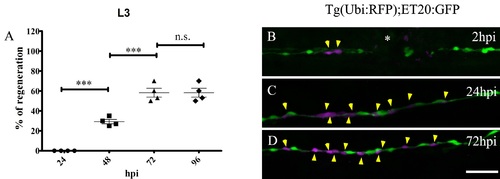Fig. S1
- ID
- ZDB-FIG-171110-42
- Publication
- Sánchez et al., 2016 - Mechanosensory organ regeneration in zebrafish depends on a population of multipotent progenitor cells kept latent by Schwann cells
- Other Figures
- All Figure Page
- Back to All Figure Page
|
The non-regenerative outcome of neuromast electroablation results in restoration of a line of INCs at the site of injury. The L3 neuromast of transgenic tg(cxcr4b:mCherry; brn3c:Gap43-GFP) larvae was electroablated and the outcome was scored as regeneration if at least two Bn3c+ cells (hair cells) appeared in the injury zone after the indicated time (n = 100). (A) Quantification of the result; the data are expressed as the percentage of larvae that regenerated the L3 neuromast at different time points after injury. The first regenerated neuromasts can be detected starting from 48 hpi in 29.2 ± 2.2 % of cases. This percentage increases significantly and reaches 58.2 ± 4.4 % after 72 hpi. From 72 to 96 hpi, the percentage of larvae that regenerate neuromasts remains unchanged. (B–D) A 3 dpf tg(et20:GFP) fish was transplanted at the blastula stage with cells from a tg(ubiquitin:RFP) donor fish (transplanted cells pseudocolored in magenta) and its L3 neuromast was electroablated (asterisk in B). In 40 % of cases, the INCs migrate to the injury site, proliferate, but fail to accumulate and organize into a mature neuromast. Yellow arrowheads show the location of the different transplanted cells through time. Scale bar B–D: 50 μm. Further details on replicates are provided in “Quantifications and statistical analysis.” |

